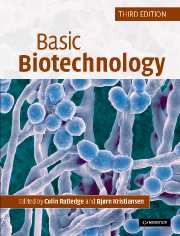Book contents
- Frontmatter
- Contents
- List of contributors
- Preface to the second edition
- Preface to the third edition
- Part I Fundamentals and principles
- Part II Practical applications
- Chapter 12 High-throughput screening and process optimisation
- Chapter 13 The business of biotechnology
- Chapter 14 Amino acids
- Chapter 15 Organic acids
- Chapter 16 Microbial polysaccharides and single cell oils
- Chapter 17 Environmental applications
- Chapter 18 Production of antibiotics by fermentation
- Chapter 19 Strategies of cultivation
- Chapter 20 Enzyme biotechnology
- Chapter 21 Recombinant proteins of high value
- Chapter 22 Insect and mammalian cell culture
- Chapter 23 Plant cell biotechnology
- Chapter 24 Biotransformations
- Chapter 25 Immunochemical applications
- Index
Chapter 12 - High-throughput screening and process optimisation
Published online by Cambridge University Press: 05 June 2012
- Frontmatter
- Contents
- List of contributors
- Preface to the second edition
- Preface to the third edition
- Part I Fundamentals and principles
- Part II Practical applications
- Chapter 12 High-throughput screening and process optimisation
- Chapter 13 The business of biotechnology
- Chapter 14 Amino acids
- Chapter 15 Organic acids
- Chapter 16 Microbial polysaccharides and single cell oils
- Chapter 17 Environmental applications
- Chapter 18 Production of antibiotics by fermentation
- Chapter 19 Strategies of cultivation
- Chapter 20 Enzyme biotechnology
- Chapter 21 Recombinant proteins of high value
- Chapter 22 Insect and mammalian cell culture
- Chapter 23 Plant cell biotechnology
- Chapter 24 Biotransformations
- Chapter 25 Immunochemical applications
- Index
Summary
Introduction
The biological production of active compounds, ranging from small molecules, such as organic acids, vitamins or antibiotics, through to macromolecules, such as therapeutic proteins or plasmid gene therapy vectors, is of great commercial and social value. The cornerstone of any such bioprocess is the cell cultivation step where a highly selected, and usually engineered, cell-line is grown under carefully controlled conditions. The term cell-line is used here to represent both microbial and mammalian cells. The aim of the cultivation step is to yield the product in as an efficient and cost-effective manner as possible. However, the design and implementation of a cell cultivation process is often a complex, lengthy and costly task. The development of a cell cultivation process typically involves four stages, as shown in Fig. 12.1. Stage 1 involves the initial identification of a native, or wild-type, cell-line that produces the compound of interest, though usually slowly and at low levels. This is followed by Stage 2 in which the productivity of the chosen cell-line [g product (g cells)−1 h−1] is enhanced using a variety of microbiological and molecular biology techniques. Stage 3 involves optimisation of the growth media composition and culture conditions; while in Stage 4, scale-up of the process from laboratory, through pilot plant to manufacturing scale occurs.
High-throughput experimentation
Traditionally cell culture development has been carried out following a sequential series of experiments, using conventional apparatus with a high labour requirement. Conventional experimentation usually involves carrying out one or only a few experiments at a time.
- Type
- Chapter
- Information
- Basic Biotechnology , pp. 289 - 306Publisher: Cambridge University PressPrint publication year: 2006
- 6
- Cited by



